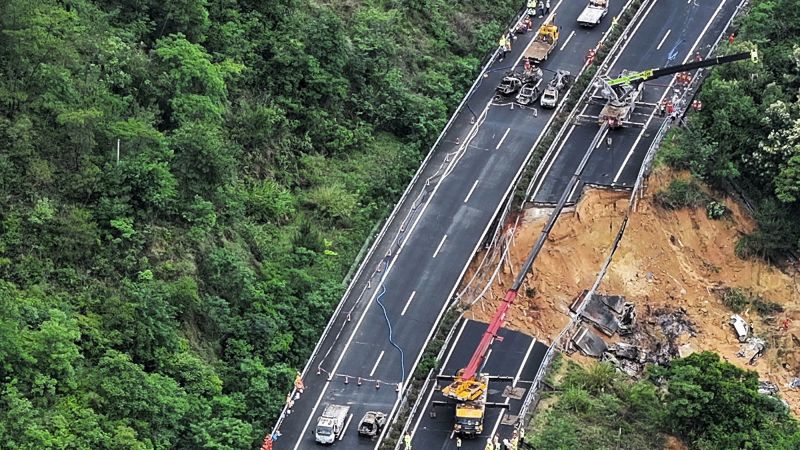/cloudfront-us-east-2.images.arcpublishing.com/reuters/TPYVYNISU5PO7A62T4TSLKI6Z4.jpg)
BEIJING (Reuters) – China said on Friday it would seek export permits for some graphite products to protect national security, in its latest move to control supplies of the vital mineral in response to challenges to its global industrial dominance.
China is the world’s largest graphite producer and exporter. It also refines more than 90% of the world’s graphite into the material used in almost all electric vehicle battery anodes, which is the negatively charged part of the battery.
“This bold and unexpected move by China in graphite has surprised us, arriving much sooner than anyone expected,” said Qin Huynh, chief commercial officer of Alkemy Capital Investments, which focuses on developing projects in the energy-converting minerals sector. .
Beijing requires export permits at a time when many foreign governments are increasing pressure on Chinese companies over their industrial practices.
The European Union is considering imposing tariffs on Chinese-made electric cars, arguing that they benefit unfairly from subsidies. Also, the US government earlier this week expanded restrictions on Chinese companies’ access to semiconductors, including halting sales of more advanced AI chips made by Nvidia.
The restrictions are similar to those imposed since August 1 on two metals used in the manufacture of chips: gallium and germanium. The restrictions have recently reduced exports of these minerals and raised prices outside the country.
China’s Ministry of Commerce said the move on graphite “is conducive to ensuring the security and stability of the global supply chain and industrial chain, and is conducive to better protecting national security and interests.”
She added that it does not target any specific country. Top buyers of graphite from China include Japan, the United States, India and South Korea, according to Chinese customs data.
Under the new restrictions, from December 1, China will require exporters to apply for permits to ship two types of graphite, including high-purity, high-hardness, high-density synthetic graphite, and natural graphite flakes and products.
The Ministry of Commerce said that three types of “highly sensitive” graphite elements have already been subject to temporary control and are included in the new list.
At the same time, temporary controls were dropped on five less sensitive elements than graphite used in basic industries such as steel, metals and chemicals.
As electric vehicle sales surge, automakers are racing to secure supplies from outside China, but shortages loom.
“With these new graphite export restrictions, South Korean companies that rely heavily on China for graphite imports will need to look for alternatives, such as mines from the United States or Australia, but this will likely increase the cost burden for many,” Kang Dong said. . -Jin, analyst at Hyundai Motor Securities.
Trucks pass by containers at the Yangshan deepwater port in Shanghai, China on January 13, 2022. Photo taken on January 13, 2022. REUTERS/Ali Song/File Photo Obtaining licensing rights
The South Korean Ministry of Trade said in a statement that it held a meeting on Friday with battery and material makers on how to respond to the export restrictions.
“The South Korean government will communicate closely… to avoid production interruptions in the lithium-ion battery sector,” South Korean Industry Minister Ahn Deok-gyun said.
Japanese government spokesman Hirokazu Matsuno said on Friday that the country plans to ask China about the “operational policies” of the new measures and will take “appropriate steps” if they violate World Trade Organization rules.
Shares of new energy companies and battery makers in China rose after this announcement.
The effect is not clear
Analysts said it was not clear how much impact the new measures would have on graphite in the short term.
“This control is not a complete ban, and there was no significant impact on any industry during the previous temporary control,” said Evan Lam, a senior analyst at Counterpoint Research.
Prices for natural graphite flakes reached 3,950 yuan ($539.62) per metric ton this week, down 25.5% from the beginning of this year due to lower demand from the electric vehicle sector, according to Mysteel.
“This action could put them on an upward trajectory internationally, while keeping domestic prices low for Chinese battery producers,” said Tom Kavanagh, head of battery metals at Argus.
However, exports are likely to rise before December 1, especially to countries with well-established battery industries such as Japan, South Korea and the United States, said Echo Ma, an analyst at Rystad Energy.
China has reduced natural graphite mining in recent years to protect the environment, and instead has increased production of synthetic graphite since 2021. The synthetic form now accounts for 70% of China’s production, according to consulting firm Mysteel.
($1 = 7.3200 Chinese yuan)
(Reporting by Siyi Liu, Amy Love and Dominic Paton in Beijing, Brenda Goh in Shanghai, Heikung Yang in Seoul, and Nick Carey and Eric Onstad in London – Prepared by Mohammed for the Arabic Bulletin) Editing by Christopher Cushing and Christian Schmollinger
Our standards: Thomson Reuters Trust Principles.

“Web maven. Infuriatingly humble beer geek. Bacon fanatic. Typical creator. Music expert.”

:quality(85)/cloudfront-us-east-1.images.arcpublishing.com/infobae/5UO63CBHEMLEHSVUAGLCAHP2Q4.jpg)



More Stories
Antitrust court documents show that Google's payments to Apple reached $20 billion in 2022
Qualcomm offers strong forecasts in reference to smartphone recovery
Johnson & Johnson proposes $6.5 billion deal to settle talc cancer lawsuits